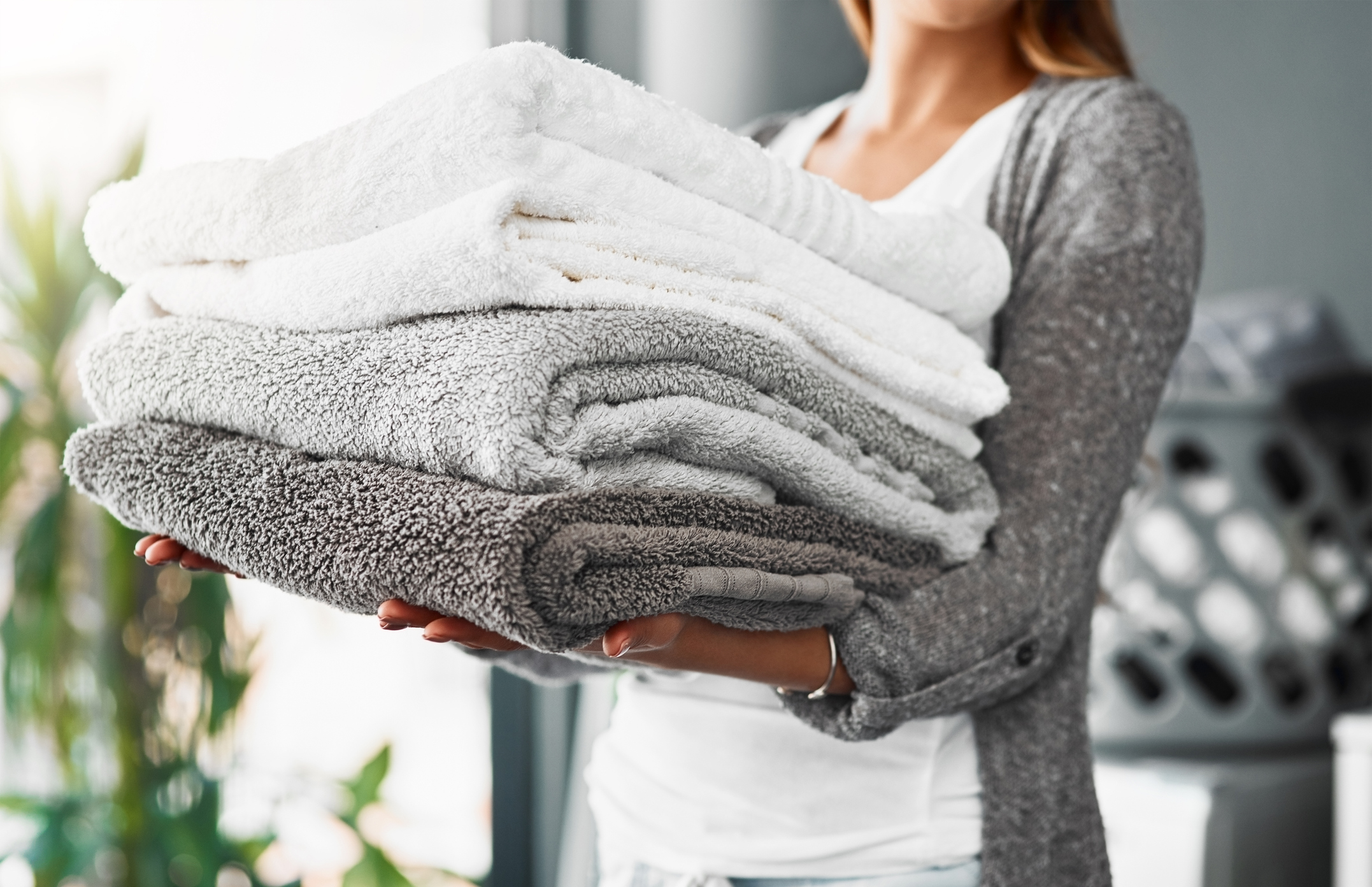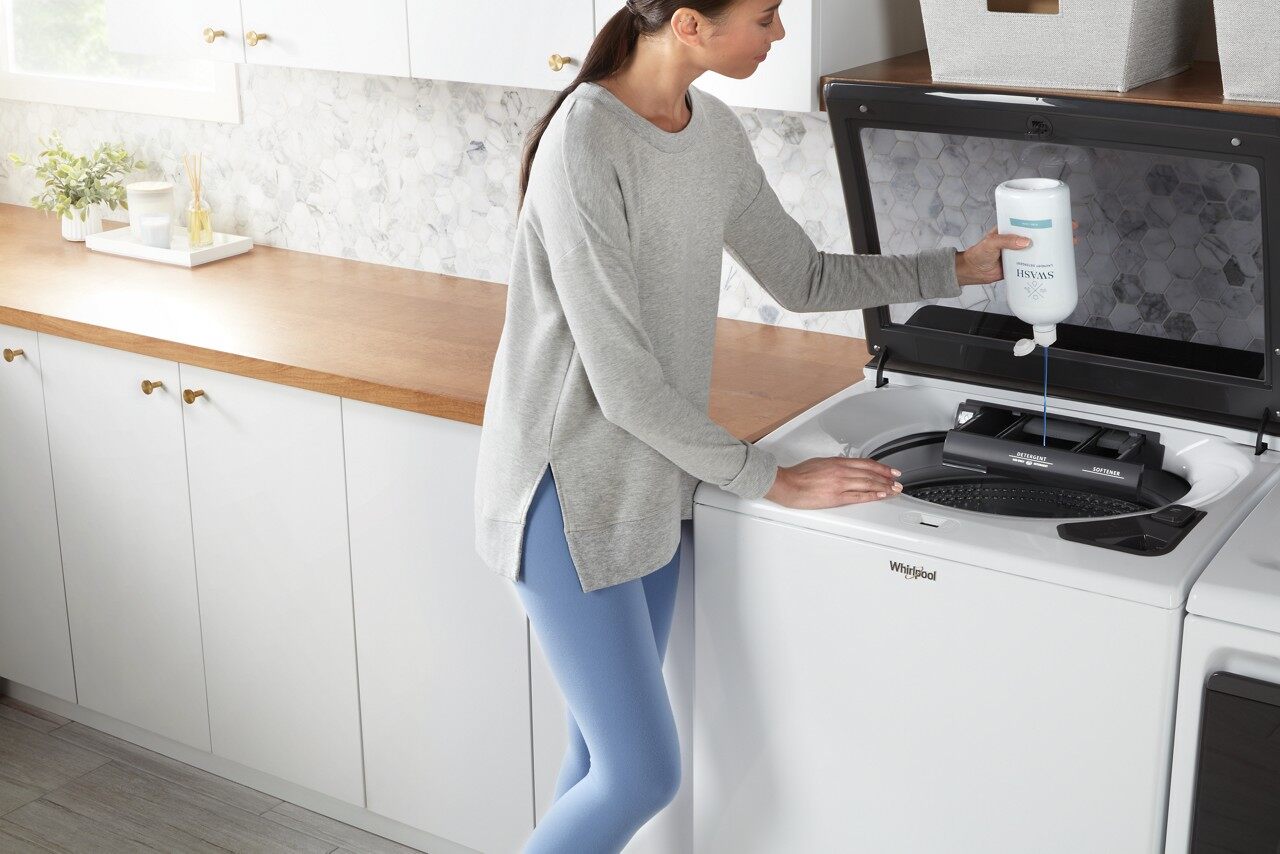Modern-day washers and dryers have evolved to play an important role in our everyday lives. Laundry appliances range from tried-and-true workhorses to energy-efficient machines equipped with the latest and greatest features in convenient technology.
There are many factors at play when shopping for a new washer and dryer—including choosing the right model to fit your laundry space. Are you dealing with a dedicated laundry room, a closet laundry room, or a laundry pair in your garage or basement? Depending on your need, some configurations may be a better suit for your arrangement than others.
Typically, you can expect a washing machine to last eight to 14 years if maintained properly, but what happens if your washer or dryer gives out? It doesn’t have to mean complete chaos and countless trips to the laundromat—you can avoid climbing the Everest of dirty laundry by replacing your old appliances with a highly efficient and high-performance washer and dryer from Don’s Appliances.
From matching washer and dryer sets to single washing machines and dryer units to space-saving stacked laundry pairs, our laundry appliances buying guide will help you discover dependable products that will gently treat your clothes, towels, and linens to ease the load on laundry day.

Washing Machine Types
Doing laundry might feel like a mundane task, but the variety of high-end washers and dryers is anything but dull. Certain machines allow you to multitask and wash two loads at once, some are equipped with a steam cleaning function, and others have specific dispensing units for detergent pods.
Every laundry appliance has its advantages and disadvantages—this is in large part due to the construction and variety of each type. So, what are your options?
Top-Load Washer
A conventional top-load washer has been the mainstay washer design for many decades. Inside the machine, you’ll find an agitator the height of the washtub that performs the washing action. During each cleaning cycle, the tub fills with water twice (once for washing and once for rinsing), and the agitator circulates the submerged laundry items through the water.
A great example is this modern top-load washer from Whirlpool (WTW5100HW). You can soak, scrub, and wash all in one spot with a built-in faucet and pretreat brush that are connected to the machine. The large capacity washer will guide you through the right cycle combinations or allow you to customize up to 36 of your own. And to help remove stains without an extra trip to the sink, there’s the Automatic Presoak option.
Beyond that, there are always additional pros and a few cons to any washing machine model, and we’ve highlighted some of those below:
Pros:
- Typically, the least expensive option
- Cycle times are commonly shorter and faster than front-load washers
- Proficient at cleaning heavily-soiled loads and more effective on resilient fabrics like linen, denim, and canvas
Cons:
- Can be tough on fabrics and not as efficient at cleaning tough stains
- They use a lot more water than front-load washers
- Can be a noisier option
Front-Load Washer
It’s a common household product today, but at one point in time, turning the washer on its side introduced a major change to the design and function of this appliance. The control panel on a front-load washer is located on the front of the appliance for easy access. Inside the drum, you’ll find paddles on the side of the wash bin that spin vertically like a dryer. It’s common to find a pull-out drawer or a pedestal located at the bottom of the appliance to store detergent and other cleaning supplies, as well as to raise your appliance for easier loading and unloading.
This washing machine model enabled a wealth of new water and energy-saving features; as the wash cycle begins, the machine automatically determines how much water is needed for that load—which can be half of that needed for a top-load washer. It mixes the detergent with the water to form a concentrated cleaning solution and the paddles lift your garments to the top of the drum and back into the water to drive out any soils.
A front-load appliance like this washer from Electrolux (EFLW427UIW) comes with the LuxCare Wash system to provide a thorough clean with seven wash actions, temperature control, and smart load sensing. The 20-Minute Fast Wash quickly deep-cleans your items when you’re in a rush to get them in the dryer, and the StainTreat option gently and effectively removes stains with ease.
Additional pros and cons of front-load washer models:
Pros:
- Gentler on fabrics
- Most can be stacked with a matching dryer to save space
- Front-loaders use less water and extract more of it, thereby saving energy
Cons:
- Wash times are longer than top-load washers
- Some models transmit excessive vibrations to the floor
- Without proper care, a buildup of mold or mildew in the door seal is common in this washer type

Additional Washer Types
Front-load and top-load are the most popular washing machine models, but if space is a factor, consider the following washer types.
Stackable Laundry
Stacked laundry units, also called laundry centers, feature a dryer suspended vertically over a top-load washer in one connected appliance unit. The overall capacity is far less as they are not as deep as full-size appliances, but it is much easier for them to fit into smaller, compact spaces like laundry closets.
A matching washer and dryer set can be visually pleasing, and many of them are designed to work in unison. A more chic and modern option is a stacked laundry unit from LG (WKEX200HWA). Known as the LG WashTower, this set takes up half the floor space as individual laundry units, giving you room to add a sink, an ironing board, or anything else you need for laundry day. The exclusive Center Control panel is perfectly positioned with both washer and dryer controls at just the right height, and advanced cleaning power makes laundry less of a chore.

Washer-Dryer Combos
The name speaks for itself—a washer-dryer combo, or all-in-one model, features both washing and drying functions within the same appliance. This is an innovative solution for apartments, condos, cabins, or any home that might be spatially challenged.
Capacity is limited and load times can be lengthy compared to standalone appliances, but when space is at a premium, a combination washer and dryer takes up far less space and the one-step cleaning process adds a level of convenience. Plus, these laundry combos are ventless, meaning you don’t need to vent your appliance to the outside; moisture is collected from the drying cycle and stored in a special reservoir.
This GE washer-dryer combo (GFQ14ESSNWW) offers five different speed choices, soil selections, and temperature levels. It also comes with a steam wash setting, a sanitize cycle, and an Auto Wash + Dry feature that automatically sets the correct dry cycle based on the chosen wash cycle.
Dryer Types
Your laundry isn’t complete until it’s fully washed and dried, so let’s examine some common dryer types.
Gas Dryer
A gas dryer will hook into your home’s gas connection for heat and plug into an electrical outlet for operation (typically a 110-volt outlet). They also require an external exhaust vent and can be slightly higher in price compared to their electric counterpart, but they cost less to operate.
Gas models can heat up and dry your clothes faster than electric dryers, adding to their cost-effectiveness. Some gas dryers can even be converted to liquid propane with the purchase of a compatible conversion kit.
Dryers always have a larger capacity than the washing machine, but this LG front-load gas dryer (DLGX8101V) has one of the largest capacities available. With 9.0 cubic feet of mega-capacity, you can fit a king-size comforter and full set of bedding in one single dry cycle. TrueSteam uses real steam to reduce wrinkles and odors, and practically eliminates the need for ironing, and the SteamSanitary Cycle uses steam to safely sanitize items commonly marked as non-washable like throw pillows.
Electric Dryer
Electric dryers are—well, electric. Typically requiring a 240-volt outlet, electric dryers can cost more to operate but they are cheaper than gas models upfront. They dry a bit slower than gas dryers, but they are just as effective. Like gas dryers, most electric versions will also require an external vent. If this isn’t possible for your home, there are ventless condensation dryers that direct moist air through a heat exchanger and condense the water vapor instead of expelling it through an exhaust vent.
This Maytag electric dryer (MED5630HW) provides plenty of room to dry large loads with a spacious 7.3 cubic feet capacity. Advanced Moisture Sensing monitors air temperatures to help evenly dry loads, and the Wrinkle Prevent option runs for up to 150 minutes after the cycle has ended to help keep wrinkles from forming as the dryer continues to tumble.

Size and Capacity
Laundry appliances are measured in terms of cubic feet, but this can be difficult for someone who isn’t familiar with the product. An easier benchmark to use for size and capacity is pounds.
Washer Capacity
If you’re looking to purchase a regular-capacity washer between 3.1 and 4.0 cubic feet, this will lend you roughly 12 to 16 pounds of laundry. A large-capacity model between 4.0 and 4.5 cubic feet can handle up to 20 pounds. If you have a large family or a never-ending stack of laundry, a washer with an extra-large capacity of 5.0 cubic feet and up would be an ideal investment.
Capacity is also dependent on the model type. If you are trying to wash a queen-size comforter or something even larger, your best bet is an impeller washer with no agitator so your item can fit comfortably without cramming.
Dryer Capacity
Dryer capacity relates to the capacity of the washer. If you just washed a full load of clothes, the drying drum needs to be large enough for the full load to tumble and dry freely with enough room for hot air to circulate over your fabrics.
Luckily, if you’re buying a matching washer and dryer pair, the set will already be synced to work with one another’s capacity. If you’re purchasing a standalone dryer, remember a 1:2 ratio and choose a dryer with twice the capacity of the washer. It might offer more space than you need, but it will ensure your clothes don’t come out damp and soggy.

Measurements
Accurate measurements are crucial when installing new laundry appliances, but before you bust out your tape measure and level, there are a few items to be aware of:
- The floor cannot have more than a 1-inch slope
- Keep hot and cold water lines near washer hookups (three to five feet) and replace water supply hose when buying a new appliance
- Include a drain connection for wastewater
- Check the configurations to ensure you have the proper power cord prong and outlet
Once you’re ready to measure, be sure your new appliance can fit into the space available. The doorway and hallway must be wide enough to accommodate the machine and a hand truck to transport the product. Clear away any obstructing furniture and take precise measurements of the designated space and path to your laundry room, accounting for trim pieces, banisters, baseboards, and door frames.
And make note of the utility installations—the water and power hookups, the outlets, and the exhaust vent. Know where each of these items are located and make sure they align with your installation plans.
Don’t Forget the Features
Model type and capacity are important, but it’s the slick features we all get excited about. Some key features to look out for on the newest washers and dryers include:
- Digital displays
- Steam cleaning
- Wi-Fi connectivity
- Detergent pod dispenser
- Quick wash cycle
- Self-clean cycle
- Noise reduction
- Temperature control
- Delayed start function
- Allergy setting
- Energy Star certification
- Moisture sensor
- Wrinkle release
If you’ve ever purchased new appliances in the Pittsburgh area, you know Don’s offers the best selection of individual laundry appliances and laundry pairs featuring the latest styles, brands, and finishes. Explore all your options and give us a call, shop online, or visit a showroom near you to shop all things laundry.

